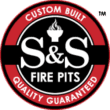
Cooking over a fire pit can be a rewarding experience, enhanced significantly with the right cooking grate.
We at S&S Fire Pits want to help you understand the essentials of choosing, using, and maintaining a fire pit cooking grate.
From materials to benefits and maintenance tips, this guide covers it all to elevate your outdoor cooking game.
Which Fire Pit Cooking Grate Is Best?
Choosing the right fire pit cooking grate is essential for a seamless and enjoyable outdoor cooking experience. Here’s what you need to consider.
Materials and Durability
Selecting the right material for your cooking grate is fundamental. Stainless steel and cast iron are the top choices due to their durability and heat retention capabilities. Stainless steel is resistant to rust, making it an excellent option for those living in humid areas. It’s also easier to clean, ensuring that maintenance doesn’t become a chore. Cast iron, on the other hand, distributes heat evenly and can produce a better sear on meats. We recommend oiling cast iron grates regularly to prevent rust and maintain their longevity.
Size and Compatibility
Ensuring that your cooking grate fits your fire pit is crucial for both safety and efficiency. Measure the diameter of your fire pit before purchasing a grate. A proper fit minimizes the risk of accidents and ensures even cooking. For custom sizes, consider options that cater to specific fire pit dimensions to avoid any ill-fitting mishaps.
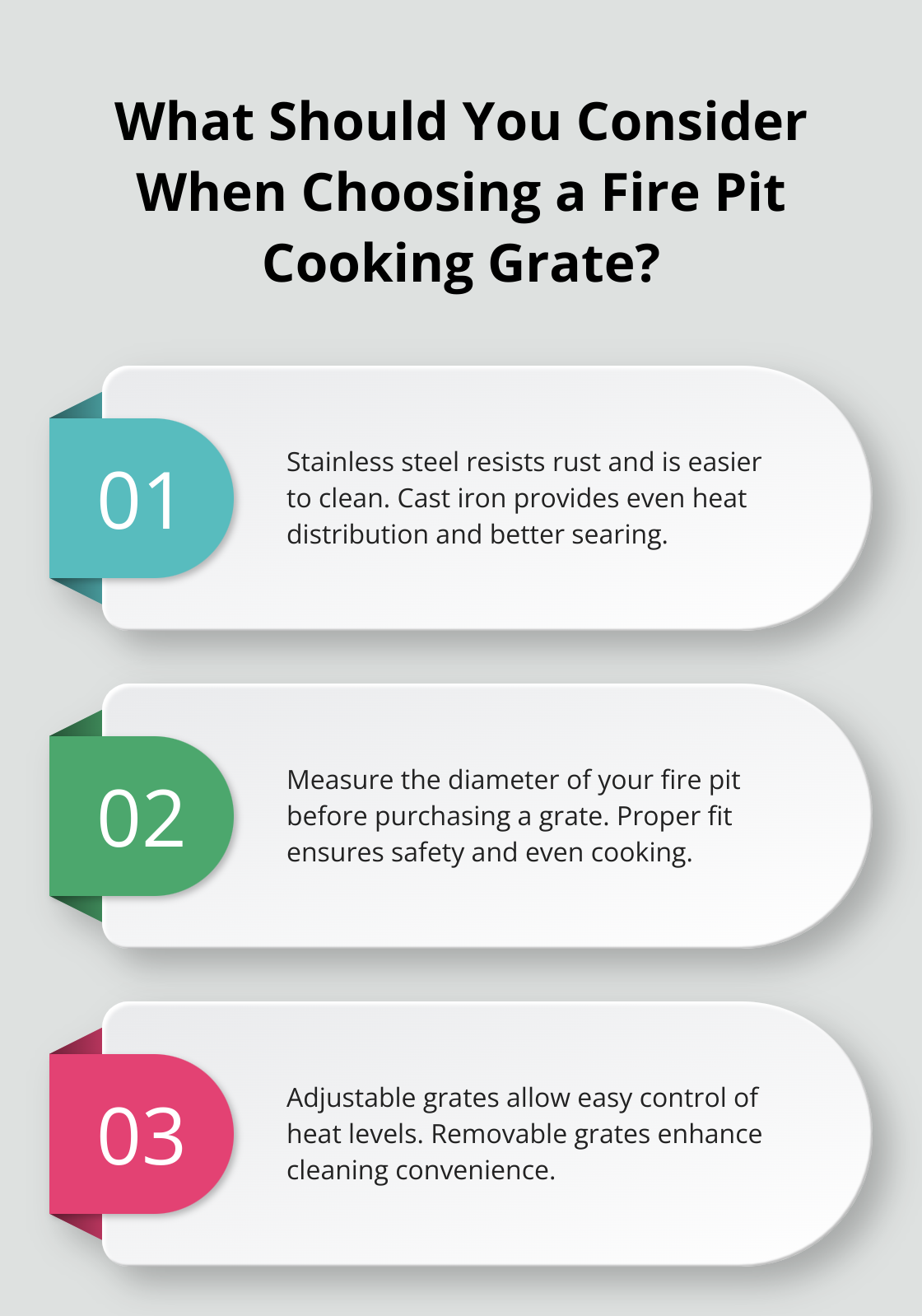
It’s also worth noting that larger grates provide more cooking space, allowing for simultaneous grilling of various items. If you regularly host gatherings, a larger grate is beneficial. Custom size heavy-duty handcrafted grates can be tailored to meet unique needs, providing both flexibility and reliability.
Design and Features
The design of your cooking grate can significantly impact your cooking experience. Look for grates with sturdy construction and reinforced features. Adjustable cooking grates offer versatility, allowing you to control heat levels easily. Removable grates are practical for cleaning, enhancing overall convenience.
Modern cooking grates come with comfortable, heat-protected handles for safer handling, even in high-heat conditions. Spring handles on searing griddle plates add another layer of safety and usability. Also, consider grates that come with accessories such as rotisserie attachments or heat deflectors to expand your cooking repertoire.
These features provide a practical and enjoyable grilling experience, transforming your fire pit into a versatile cooking station.
Benefits of Fire Pit Cooking Grates
Even Cooking and Heat Distribution
One of the paramount benefits of using fire pit cooking grates is their ability to distribute heat evenly. Unlike traditional grilling methods that might create hot spots, a well-designed fire pit cooking grate minimizes this issue. For example, cast iron grates known for their excellent heat retention and distribution ensure that every inch of your food cooks uniformly. Studies have shown that even heat distribution can reduce cooking time by up to 20%, allowing you to enjoy your meals faster. Moreover, by maintaining uniform heat, you can achieve desired cooking outcomes consistently, whether it’s a perfect sear on a steak or evenly roasted vegetables.
Versatility in Cooking Methods
Fire pit cooking grates offer unparalleled versatility, enabling various cooking techniques that can cater to different culinary needs. You can easily switch between grilling, searing, and even indirect cooking methods with the right grate. Adjustable grates let you control the proximity of your food to the flames, making it simple to execute slow-roasting, smoking, or high-heat searing. For instance, incorporating wood chips can add a smoky flavor, enhancing dishes such as smoked ribs or brisket. An adjustable grate also allows for two-zone cooking, where one side is hotter for searing meats, while the other can be used for cooking delicate items like fish and vegetables. This flexibility is particularly advantageous for outdoor cooking enthusiasts who enjoy experimenting with various recipes.
Enhanced Flavor through Open Flame Cooking
Cooking over an open flame brings a unique flavor profile that cannot be replicated by gas or electric grills. The combination of natural fats dripping onto the flames and the smoke created by burning wood infuses your food with a rich, smoky taste. This method is especially effective with hardwoods like oak or hickory, known for their ability to impart robust flavors to meats and vegetables. According to a survey by the Hearth, Patio & Barbecue Association, 70% of consumers prefer the taste of food cooked over a wood-fired grill. By using a fire pit cooking grate, you can unlock these delectable flavors right in your backyard. Furthermore, the sear achieved by direct open flame cooking adds a caramelized outer crust while keeping the inside of meats juicy, enhancing both texture and taste.
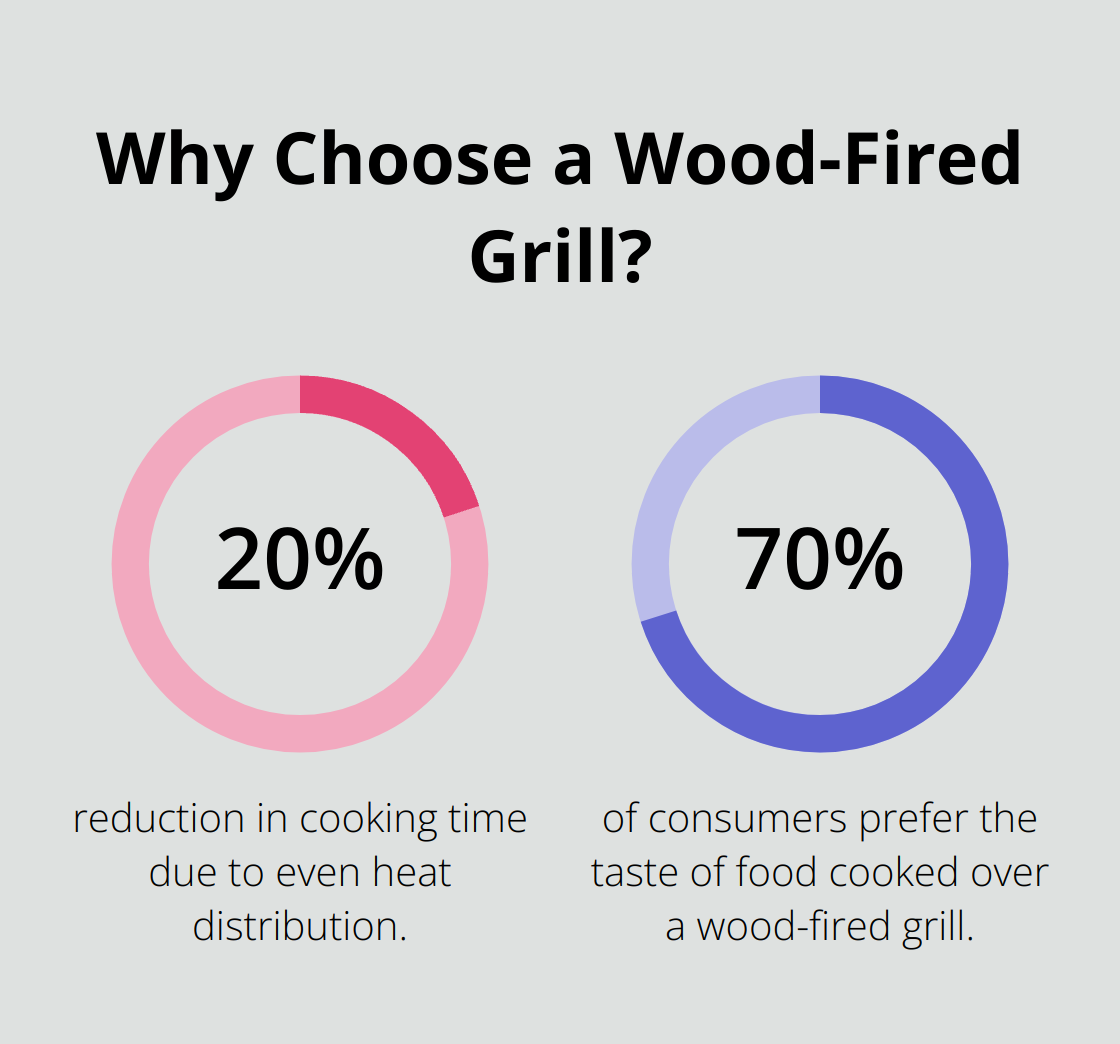
How to Maintain Fire Pit Cooking Grates
Proper maintenance of your fire pit cooking grate ensures longevity and optimal performance. Here’s how you can keep your grate in top shape year-round.
Cleaning Techniques
Each material requires a specific cleaning approach to maintain its integrity. For stainless steel grates, a simple scrub with a steel brush and soapy water is usually sufficient to remove food particles and grease. This material is less prone to rust, making it easier to maintain.
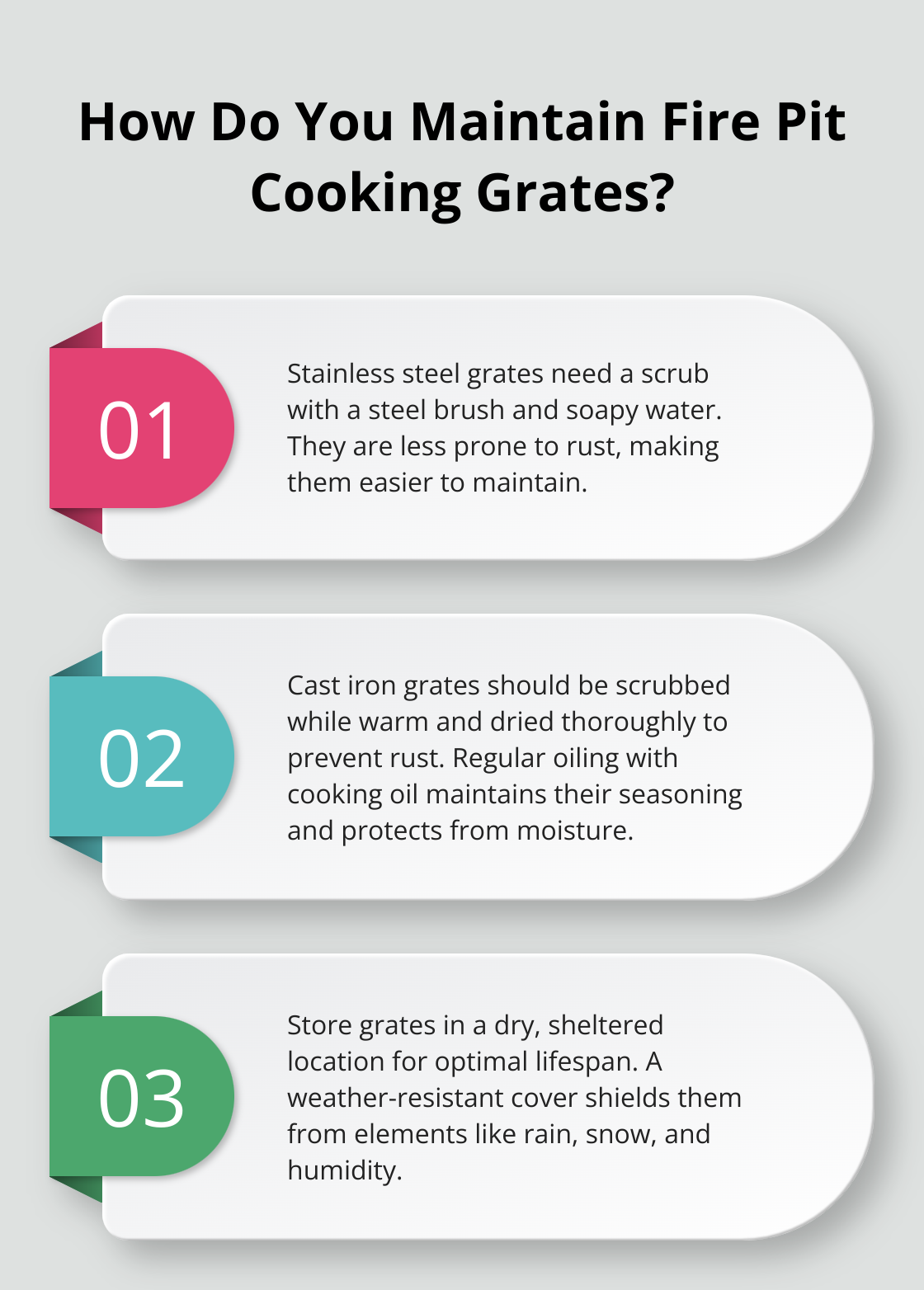
Cast iron grates need a different kind of care. Start by scrubbing off food remnants while the grate is warm using a brush designed for cast iron. After cleaning, dry it thoroughly to prevent rust. Once dry, oil the grate lightly with cooking oil to maintain the seasoning and protect it from moisture. Regular oiling is crucial for cast iron, ensuring it remains non-stick and rust-free.
Proper Storage Tips
Where and how you store your cooking grate can significantly affect its lifespan. Ideally, store the grate in a dry, sheltered location to protect it from the elements. Exposure to moisture can lead to rust, especially in cast iron grates.
For added protection, consider using a weather-resistant cover. This shields the grate from rain, snow, and humidity, crucial for those living in areas with high rainfall or humidity.
Before storing, ensure the grate is completely clean and dry. Any residual moisture or food particles can cause corrosion and attract pests, compromising the grate’s condition.
Avoiding Common Wear and Tear
To prevent wear and tear, regular inspection and maintenance are essential. Check for signs of rust, especially in cast iron grates. If rust appears, remove it immediately with a wire brush and re-season the grate to restore its protective layer.
Avoid overheating the grate beyond its material capacity. Excessive heat can warp the grate, especially if it’s made from thinner metals. Stick to the recommended heat levels to ensure longevity and maintain cooking efficiency.
Handling the grate with care is also crucial. Always use heat-protected gloves when removing or adjusting the grate to prevent accidental drops and damage. Mishandling can lead to bending or breaking, affecting the cooking experience.
Maintaining these practices can extend the life of your fire pit cooking grate, ensuring it provides consistent performance and enhances your outdoor cooking adventures.
Conclusion
Choosing the right fire pit cooking grate can transform your outdoor cooking experience. Materials like stainless steel and cast iron offer durability and excellent heat retention respectively, making each a valuable choice depending on your needs. Ensure the size of your grate fits your fire pit to prevent accidents and achieve even cooking. Features such as adjustable grates and comfortable handles can enhance usability and safety.
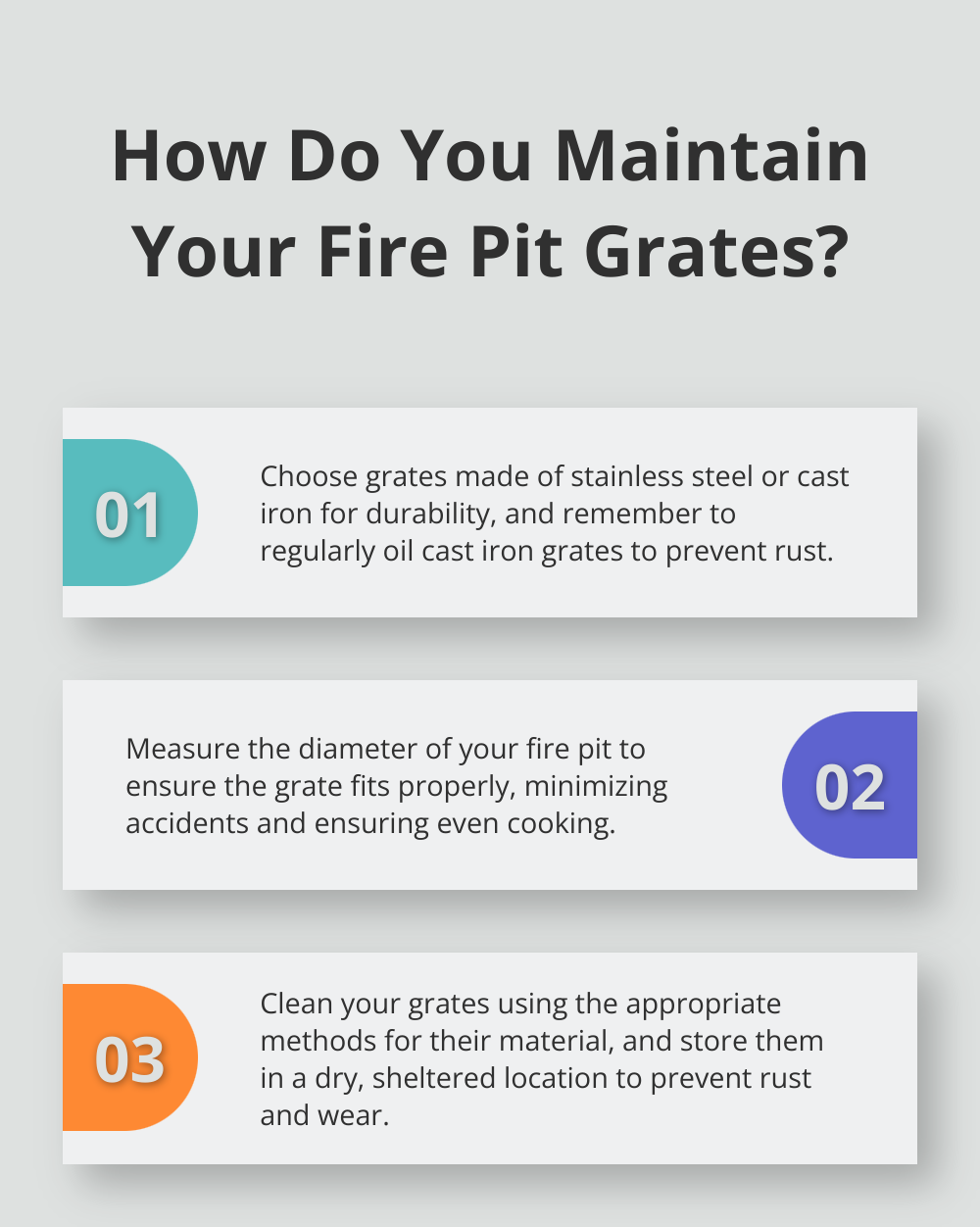
The benefits of using fire pit cooking grates are numerous. They offer even heat distribution, versatile cooking methods, and unique flavor profiles only achievable with open flame cooking. Proper maintenance, including regular cleaning and appropriate storage, is key to extending the life of your cooking grate. Stainless steel grates are easier to maintain, while cast iron grates require regular oiling to prevent rust.
Maintaining your fire pit cooking grate involves avoiding common wear and tear by handling the grate with care and sticking to recommended heat levels. Regular inspections can help you catch rust early and maintain the grate’s longevity and performance.
By following these guidelines, you can make the most of your cooking grate, ensuring it serves you well for many outdoor cooking sessions. For durable, handmade fire pits and accessories, visit S&S Fire Pits. We pride ourselves on creating high-quality, lifetime-guaranteed products that enhance your outdoor living experience. Our fire pits, made from corten solid USA steel, are built to last, offering unique and one-of-a-kind designs that never need replacing.
